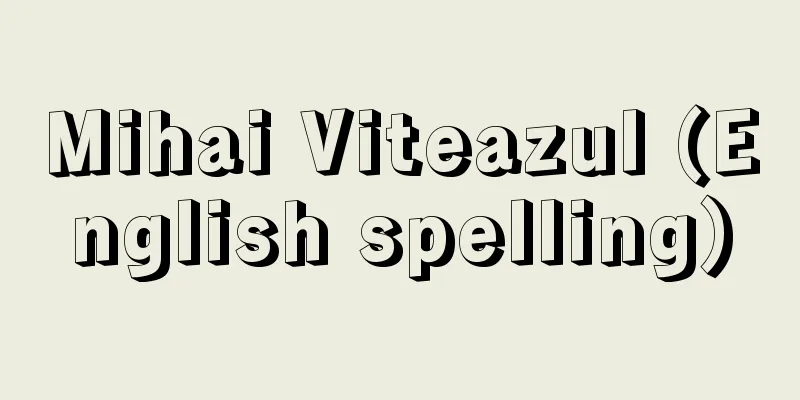Handgun - Kenju (English spelling)

|
Also called a pistol, it is a small gun that can be held and fired with one hand. Currently, the most widely manufactured and used are self-loading semi-automatic pistols and revolvers with a rotating lotus-shaped magazine. In addition to these, there are single-shot products used in shooting sports, repeating pistols with multiple barrels, and those that can be fired repeatedly by hand. [Masami Tokoi] Modern handgun typesAn autoloading pistol is a type of pistol that, when the ammunition loaded in the barrel is fired, ejects the fired cartridge using the recoil of the shot, and then automatically sends the ammunition stored in a box magazine into the barrel, preparing to fire the next round. In order to fire the next round, the trigger must be released and then pulled again. For special purposes such as military use, fully automatic pistols have also been made that continue to fire as long as the trigger is pulled. A revolver is a type of pistol that can fire multiple shots by loading ammunition into a rotating magazine (cylinder) shaped like a lotus root. There are two types of firing methods: double action, which can fire multiple shots by simply pulling the trigger, and single action, which requires the hammer to be cocked before each shot. There are many types of single-shot handguns, including breechloaders (which load ammunition by opening the rear of the mechanism, such as lever-action and bolt-action), and those which load ammunition by rotating the barrel. Multi-barreled handguns were the mainstream repeating pistol before the invention of the revolver, but because they are heavy and bulky, only a limited number of specialized models are produced today. Manual repeating pistols were originally manufactured as a precursor to automatic loading pistols. Currently, manual repeating pistols are limited to specialized pistols, such as those designed to fire large cartridges with small pistols. [Masami Tokoi] Pistols used in World War IIIn World War II, autoloading pistols were the main military handguns. Representative pistols used in World War II include the double-action Walther PPK and Walther P38 used by the German army, the large-caliber M1911A1 pistol (Colt Government Model) used by the US army, the small Beretta M1934 pistol used by the Italian army, the simple Tokarev TT1933 used by the Soviet Union, and the Type 14 and Type 94 pistols used by the Japanese army. Old-style revolvers were also used by various countries as auxiliary weapons. In particular, the British army used a large number of Enfield revolvers, Webley & Scott revolvers, and American-made Smith & Wesson Victory revolvers. [Masami Tokoi] Modern military and police pistolsCurrently, not only military handguns but also police handguns are being converted to automatic pistols. There are many handguns used by the military and police in each country, but representative products include the Beretta M92F (originally designed by Italy), Glock M17 (Austria), SIG Sauer P220 series (Switzerland/Germany), Heckler & Koch P7M8 (Germany), and Makarov pistol (originally designed by Russia). Many countries continue to use revolvers for police use. [Masami Tokoi] Shooting pistolWell-known manufacturers of handguns for shooting sports include the Swiss company Hemmerli, the German company Walther, and the German company Anschutz. Air pistols specifically for shooting sports are manufactured by Hemmerli, Walther, and the German company Feinergbau. [Masami Tokoi] The development of handgunsThe origins of pistols overlap with those of firearms. Gunpowder and primitive firearms, invented in China, were introduced to Europe in the first half of the 13th century through the Arabs. In the 14th century, primitive firearms began to be made in Germany and other countries, but at first it was technically difficult to make them small. The first written reference to a pistol was in the Italian Archivio Storico Italiano (Archivio Storico Italiano) written by the Italian Gracini in 1364. In this book, a short Roman candle with a total length of 190 mm was described as a span. In the Modern Encyclopedia Chronicles di Moderna published in 1364, a lightweight short gun was described as a scioppi. The English word handgun was first written in 1386. In a book published in 1449, it was written that a gun with a total length of 180 mm used by cavalrymen at that time was called a petronel, and this name is thought to be the origin of the later word pistol to refer to a pistol. It was impossible to operate a gun with one hand using the early touch-hole lock, which required holding the matchlock in one hand to ignite it. The mechanical ignition device, the matchlock, was invented at the end of the 14th century, making it physically possible to fire a gun with one hand. However, it took time for further technological improvements to be made in order to manufacture a lighter gun barrel that could withstand the pressure of gunpowder. After the matchlock was developed, short single-shot pistols were developed first. Then, repeating pistols with multiple barrels and revolvers with revolving magazines were tried. These ideas were repeatedly commercialized as the ignition method changed from flintlock (using a flint) to percussion lock (using gunpowder). Pistols did not change dramatically until the 18th century, when cartridges, which combined bullet, propellant, and primer in a metal cup, were invented. As cartridges became more common, revolvers, which were already at a highly advanced stage of development, became easier to reload and more maneuverable. Cartridge-type ammunition created the possibility of repeating pistols, which fired by feeding pre-loaded rounds into a single barrel one after the other. By the mid-18th century, multi-barrel repeating pistols and revolvers had developed to the point where they were almost identical to modern revolvers, except for the ignition and firing method. In the 1880s, gun inventors competed to invent the so-called automatic pistol, which could fire multiple shots by automatically feeding ammunition into the barrel. The first practical pistols, invented mainly in Germany and Austria, were hand repeating pistols, which fired multiple shots by moving a lever with a finger. At the end of the 19th century, John M. Browning in the United States, Georg Luger and von Paul Mauser in Germany, and others developed and put into practical use a series of autoloading pistols that use the recoil of firing ammunition to remove the empty cartridge and automatically feed new ammunition into the barrel for continuous firing. From the end of the 19th century to the beginning of the 20th century, not only these three inventors but many other inventors invented and commercialized many autoloading pistols. Among them, the structure perfected by Browning was simple and rational. Many modern autoloading pistols also use the structure proposed by Browning in principle. Browning designed not only pistols but also special ammunition for use in autoloading pistols, many of which are still in use today under the name ACP. [Masami Tokoi] Evolution of Japanese handgunsJapan's first domestically produced modern pistol was the Type 26 revolver, designed by the Tokyo Arsenal and adopted by the Army as a military pistol in 1893 (Meiji 26). Later, Nanbu Kijiro (1869-1949) developed the Nambu-type automatic pistol, which was selected as the official pistol for the Japanese Navy and was also exported to Thailand, China, and other countries. Based on the Nambu type automatic pistol, the Type 14 pistol was developed, which became the military's official pistol in 1925 (Taisho 14) and was mass-produced for use by the Japanese Army and Navy in World War II. Demand for small, lightweight pistols for aircraft pilots and tank crews increased, and the Type 94 pistol was established and produced in 1934 (Showa 9 = Imperial calendar 2594). Currently, the Japan Self-Defense Forces have selected the SIG Sauer P220 as their official pistol and are supplied with domestically licensed SIG Sauer P220 pistols. In addition to the domestically produced New Nambu M60 revolver, the Japanese police also use the licensed SIG Sauer P230 Japanese model self-loading pistol and the imported Walther PPK/S. [Masami Tokoi] Handgun LawsHandguns can be concealed and there is a risk that they may be used in crime, so each country imposes restrictions on their possession. In developed countries, because restrictions on possession essentially lead to restrictions on private property, handgun possession permits are issued for shooting sports. The scope of permits for possession varies from country to country, with some excluding certain calibers and others restricting the number of guns that can be possessed. Many countries also issue permits for use at shooting ranges and permits for carrying loaded ammunition on the body, with different permit standards. From a social perspective, many countries exempt criminals, drug addicts, and mentally ill people from being permitted to possess a gun. In the United States, the Brady Act, which requires investigations of the criminal and mental illness histories of all those who wish to purchase handguns, was enacted in 1993, and the Crime Prevention Act, which prohibits the manufacture, sale, and possession of highly aggressive and military-style assault automatic rifles. In Japan, the Firearms and Swords Possession Control Law (Firearms and Swords Law) basically prohibits civilians from possessing handguns, except for sports shooting, which is exceptionally permitted. This law regulates not only handguns that use gunpowder to fire bullets, but also handguns that fire metallic bullets with a certain amount of energy using air or gas pressure, and handguns that cannot fire metal bullets in their current state but can be easily modified to fire metallic bullets. This type of regulation is the strictest among developed countries. Similar laws that strictly regulate the possession of handguns by civilians are only found in former socialist countries, some developing countries, and dictatorships. In Japan, only national civil servants, such as Self-Defense Force members, police officers, Ministry of Health, Labor and Welfare drug investigators, and Ministry of Land, Infrastructure, Transport and Tourism coast guard officers, who are deemed to need to possess handguns for their duties, are permitted to possess old-style handguns such as matchlock, flintlock, and percussion types by issuing registration certificates, especially for those that are valuable as cultural assets. In principle, it is prohibited to use these old-style handguns for shooting. [Masami Tokoi] [Reference] | | | | |[Colt M1911A1] (USA) .45 caliber 7 shot single action ©Shogakukan "> Handgun Structure (Automatic Pistol) [Smith & Wesson 38 Revolver] (USA) 38 caliber 6 shot double action ©Shogakukan "> Handgun Structure (Revolver) Source: Shogakukan Encyclopedia Nipponica About Encyclopedia Nipponica Information | Legend |
|
ピストルともいい、片手で持って射撃できる小型の銃のことをいう。現在、自動装填(そうてん)式のセミオートマチック・ピストル(自動装填式拳銃/自動拳銃)と、回転する蓮根(れんこん)状の弾倉を備えたリボルバー(回転式拳銃)が、もっとも多数製造され使用されている。このほかに射撃スポーツに用いられる単発の製品や、複数の銃身をまとめた連発拳銃、手動で連発できるものなどもある。 [床井雅美] 現代拳銃の形式自動装填式拳銃は、あらかじめ銃身内に装填された弾薬が撃発されると、射撃の反動などを利用して発射済みの空薬莢(からやっきょう)(カートリッジ)を排出し、続いて箱型をした弾倉(ボックスマガジン)の中に収めた弾薬を、自動的に銃身内に送り込んで、次の弾薬の発射準備を整える形式のものをいう。次の弾薬を撃発・発射するためには、一度引き金を緩めて引き直す必要がある。軍用などの特殊な目的には、引き金を引いている限り発射し続けるフルオートマチック・ピストル(全自動拳銃)もつくられた。 回転式拳銃は、上述のように蓮根状の回転する弾倉(シリンダー)に弾薬を装填して、連発射撃できる形式の拳銃である。射撃方式として、引き金を引くだけで次々に連発できるダブルアクションと、ハンマー(撃鉄(げきてつ))を毎回起こしてから引き金を引くシングルアクションの2形式がある。 単発の拳銃には、レバーアクションやボルトアクションなど機関部後端を開いて弾薬を装填するブリーチローダー(後装)や、銃身を回転させて中折れ式に弾薬を装填するものなど、多くの形式がある。 複数の銃身をもつ拳銃は、リボルバーが発明される以前に連発式の主流であったが、重くかさばるため現在ではごく限られた特殊なものが製造されているだけである。 手動連発式の拳銃は、自動装填式のさきがけとして製造されたものが始まりである。現在製造されている手動式拳銃は、大きな弾薬を小型の拳銃で射撃するためのものなどの特殊な拳銃に限られている。 [床井雅美] 第二次世界大戦で使用された拳銃第二次世界大戦では、軍用拳銃としておもに自動装填式拳銃が使用された。第二次世界大戦で使用された代表的な拳銃には、ドイツ軍の使用したダブルアクションのワルサーPPKやワルサーP38、アメリカ軍の使用した大口径のM1911A1ピストル(コルト・ガバーメント・モデル)、イタリア軍の使用した小型のベレッタM1934ピストル、ソ連の使用した単純な構造のトカレフTT1933、日本軍の使用した十四年式拳銃や九四式拳銃などがある。旧式のリボルバーも補助的に各国で使用された。なかでもイギリス軍は、エンフィールド・リボルバーやウェブリー&スコット・リボルバー、アメリカ製のスミス&ウェッソンビクトリー・リボルバーを多数使用した。 [床井雅美] 現代軍用、警察用拳銃現在軍用の拳銃だけでなく、警察用の拳銃も自動装填式拳銃に転換しつつある。各国で軍用、警察用に使用されている拳銃は数多いが、代表的な製品にベレッタM92F(イタリア原案)、グロックM17(オーストリア)、SIGザウアーP220シリーズ(スイス/ドイツ)、ヘッケラー&コッホP7M8(ドイツ)、マカロフ・ピストル(ロシア原案)などがある。警察用としてリボルバーの使用を続ける国も少なくない。 [床井雅美] 射撃用拳銃射撃競技スポーツ用拳銃を製造するメーカーとして、スイスのヘンメリー社、ドイツのワルサー社、ドイツのアンシュッツ社などが有名である。射撃競技専用のエア・ピストルは、ヘンメリー社、ワルサー社、ドイツ・ファインエルグバウ社などが製造している。 [床井雅美] 拳銃の発展史拳銃の起源は、銃砲と重なっている。中国で発明された火薬と原始的な銃砲は、アラビア人の媒介で13世紀前半にヨーロッパに伝わった。14世紀になるとドイツなどで原始的な火砲がつくられるようになったが、初めは技術的に小型にすることがむずかしかった。 最初に拳銃についての記述がみられるのは、1364年にイタリア人のグラチーニの著した『イタリア歴史文庫』Archivio Storico Italianoのなかである。この書籍中に、全長190ミリの短いローマンキャンドルが、スパンspanの名前で記述されている。1364年に刊行された『現代百科事典』Chronicles di Modernaには、軽量の短い銃砲が、ソシオッピscioppiの名前で記述された。英語のハンドガンが初めて記述されたのは1386年のことだった。1449年に著わされた書籍に、当時の騎兵が騎乗して使用する全長180ミリの銃身の銃砲のことを、ペトロネルpetronelとよんでいたことが記述されており、この呼び名が、後の拳銃を表わすピストルpistolの語源ではないかとされている。 片手で銃砲を扱うには、火縄を手に持って着火する初期のタッチホールロックでは不可能である。機械的な発火装置マッチロック(火縄式)が14世紀末に発明されて片手で射撃することが物理的に可能になった。だが、火薬の圧力に耐える銃身を軽く製造するには、さらに技術的な向上など時間がかかった。 マッチロックが開発されると、初め全長の短い単発の拳銃が開発された。続いて、複数の銃身を備えた連発式拳銃や、回転式の弾倉を備えた回転式拳銃が試された。これらの考案は発火方式が、火打石を利用したフリントロック(燧石(すいせき)式)、火薬による点火のパーカッションロック(管打(かんだ)式)にかわるたびに繰り返し製品化された。 拳銃が大きく変わるのは、18世紀に入って金属製のカップに弾丸、発射薬、雷管を一体化した薬莢(カートリッジ)が発明されてからである。薬莢が一般化すると、すでに高い発展段階にあった回転式拳銃は、弾薬の再装填が容易になり、さらに操作性のよいものになった。薬莢式の弾薬は、あらかじめ弾倉に装填した弾薬を、一本の銃身に次々と送り込んで射撃する連発式拳銃の可能性を生み出した。18世紀中ごろまでに、複数の銃身をもつ連発式拳銃や回転式拳銃は、点火・撃発方式を除けば、ほとんど現代の回転式拳銃と変わりないほどの発展を遂げた。 1880年代に銃砲の発明家たちは、弾薬を自動的に銃身へ送り込んで連発射撃できる、いわゆるオートマチック・ピストル(自動式拳銃)の発明を競った。最初に実用化されたのは、おもにドイツやオーストリアで発明された、指でレバーを動かして弾薬を次々に銃身に送り込み連発する、ハンド・リピーティング・ピストル(外力利用式拳銃)だった。 19世紀末になると、アメリカではジョン・M・ブローニング、ヨーロッパのドイツではゲオルグ・ルガー、フォン・パウル・マウザーなどが、弾薬を発射する際の反動を利用して発射済みの空薬莢を排除し、新たな弾薬を自動的に銃身に送り込んで連発する自動装填式拳銃を、次々に開発して実用化した。19世紀末から20世紀初頭にかけて、この3名の発明家だけでなく、数多くの発明家によって多数の自動装填式拳銃が発明されて製品化された。なかでも、ブローニングによって完成された構造は、単純かつ合理的だった。現代の多くの自動装填式拳銃も、原理的にはブローニングが提唱した構造を利用している。ブローニングは、拳銃だけでなく、自動装填式拳銃で使用する専用の弾薬も設計し、その多くの弾薬はACPの名前で現在でも使用され続けている。 [床井雅美] 日本の拳銃の変遷日本初の国産近代拳銃は、東京造兵廠(ぞうへいしょう)で設計された回転式の二十六年式拳銃で、1893年(明治26)に軍用拳銃として陸軍に採用された。その後、南部麒次郎(なんぶきじろう)(1869―1949)によって南部式自動拳銃が開発されて、日本海軍の制式拳銃に選定され、タイや中国などにも輸出された。 南部式自動拳銃を原型に十四年式拳銃が開発され、これは1925年(大正14)に軍の制式拳銃となり、大量に製造されて第二次世界大戦で日本陸軍と海軍で使用された。航空機パイロットや戦車兵用に小型軽量の拳銃の要請が高まり、1934年(昭和9=皇紀2594)には九四式拳銃が制定されて生産された。 現在、日本の自衛隊は、SIGザウアーP220を制式拳銃に選定し、ライセンス国産させて供給を受けている。日本の警察は、主力の国産ニューナンブM60回転式拳銃のほか、ライセンス生産の自動装填式拳銃SIGザウアーP230日本型、輸入されたワルサーPPK/Sなどを使用している。 [床井雅美] 拳銃に関する法律拳銃は、隠し持つことが可能で、犯罪に使用される恐れがあるところから、各国とも所持制限を加えている。先進諸国では、所持規制が基本的に私有財産の制限につながるところから、拳銃を射撃スポーツ用として所持許可を出している。 所持許可範囲は、特定の口径を除外する国、所持台数を制限する国などさまざまである。また多くの国で、射撃場などで使用するための所持許可証と、弾薬を装填して体につけて携帯するための携帯許可証を、別の許可基準で発行している。社会的観点から、犯罪者、麻薬中毒患者、精神病患者などを所持許可の対象から外している国も多い。アメリカでは、すべての短銃購入希望者の犯罪歴や精神障害歴の調査を義務づけたブレイディ法が1993年に成立、1994年には攻撃性が高く軍用に準じた襲撃用の自動小銃などの製造、販売、所有を禁止する犯罪防止法が成立した。 日本では、銃砲刀剣類所持等取締法(銃刀法)によって、民間人の拳銃所持は、例外的に許可されるスポーツ射撃用を除き、基本的に禁止されている。この法律では、火薬を使用して弾丸を発射する拳銃だけでなく、空気圧やガス圧で一定以上のエネルギーで金属製弾丸を発射する拳銃や、現状で発射できなくても、容易な改造によって金属製弾丸を発射できる拳銃も規制の対象にしている。このような規制法は、先進諸国のなかではもっとも厳しいものである。民間人の拳銃所持を厳しく取り締まる同様の法律は、旧社会主義国や、一部開発途上国、独裁国家にしかみられない。日本で拳銃の所持が許可されているのは、職務上その必要があると認められる自衛官、警察官、厚生労働省麻薬捜査官、国土交通省海上保安官などの国家公務員に限られる。なお、火縄式やフリントロック式、パーカッション式などの古式拳銃は、とくに文化財として価値のあるものを対象として、文化庁が登録証を出して所持を許可している。これらの古式拳銃を射撃に使用することは原則として禁止されている。 [床井雅美] [参照項目] | | | | |【コルトM1911A1】(アメリカ)45口径7連発シングルアクション©Shogakukan"> 拳銃の構造(オートマチック・ピストル) 【スミス&ウェッソン38リボルバー】(アメリカ)38口径6連発ダブルアクション©Shogakukan"> 拳銃の構造(リボルバー) 出典 小学館 日本大百科全書(ニッポニカ)日本大百科全書(ニッポニカ)について 情報 | 凡例 |
Recommend
Minimal Art
Paintings created mainly in the United States from...
Shabadah [state] - Shabadah
Katanga is a province in the southeastern part of ...
Luo - ra (English spelling)
A Chinese dactyl. A general term for instruments m...
The Story of Sagoromo
A story from the mid-Heian period. The author has...
Cercopithecidae - Cercopithecidae
…these monkeys live in the former continents of A...
On-road model - On-road model
… [Type of motorcycle] There are many different t...
Iwamura [town] - Iwamura
A former town in Ena County, southeastern Gifu Pre...
Yatsushiro Plain - Yatsushiro Heiya
The southern half of the Kumamoto Plain is surrou...
Pasadena (English spelling)
It is a commuter town of Los Angeles, California, ...
Export-Import Bank of Japan
A government financial institution established in...
Upavasatha
...In Buddhist terms, it is a ceremony where prac...
European plum
… [Isao Shimura]. … *Some of the terminology expl...
Pavel Dmitrievich Kiselyov
1788‐1872 A count and politician of Imperial Russi...
French West Africa - Afrique Occidentale Française
A former large French colony in West Africa. Abbr...
Shokokuji Temple
This is the head temple of the Rinzai sect of Bud...









